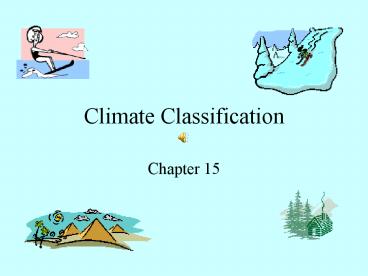Climate Classification - PowerPoint PPT Presentation
1 / 25
Title:
Climate Classification
Description:
Climate Classification. Chapter 15. Objective. Be able to use the ... f flat, precipitation tends to be flat, no wet dry season. m ... coniferous ... – PowerPoint PPT presentation
Number of Views:823
Avg rating:3.0/5.0
Title: Climate Classification
1
Climate Classification
- Chapter 15
2
Objective
- Be able to use the Köppen system to classify
climate
3
Köppen System
- Latitude
- A tropics
- B dry (sub-tropics)
- C mid-latitudes
- D higher latitudes
- E arctic
- Precipitation
- f flat, precipitation tends to be flat, no wet
dry season - m monsoon
- W no water
- w winter dry season
- s summer dry season
4
Climate types according to Köppen.
5
World map of Koeppen climates.
6
A - Tropical
- High Temperature all year, little fluctuation,
Significant precipitation - Af Tropical wet, no dry season
- Am tropical monsoonal, short dry season
- Aw tropical wet and dry, well defined dry season
7
Tropical Wet (Af) climates have no dry period and
precipitation is almost always convectional with
strong solar heating of the surface
triggering brief but heavy thundershowers in the
mid to late afternoon.
8
Monsoonal (Am) climates usually occur along
tropical, coastal areas subjected to predominant
onshore winds that supply warm, moist air to the
region throughout most of the year.
9
Tropical Wet and Dry (Aw) often occur along the
poleward margins of the Tropics and border dry
climates on one side and tropical wet climates on
the other. They undergo much greater seasonality
in precipitation and temperature than do the
tropical wet and the monsoonal climates.
10
B - Dry
- Deserts and steppe
- BW true desert, arid
- BWh subtropical hot desert, nean tempgt18C
- BWk mid-latitude desert, mean templt18C
- BS Steepe, semi-arid
- BSh mean tempgt18C
- BSk mean templt18C
11
Subtropical Deserts (BWh) tend to exist in the
subtropical regions, particularly within the
western portions of the continents as a result
of subsidence associated with the Hadley
circulation.
12
Mid-latitude Deserts (BWk) result from extreme
continentality in regions deep within continental
interiors or downwind of orographic barriers that
cut off the supply of moisture from the ocean.
13
Subtropical Steppe (BSh) are marked by aridity,
high year-to-year variations in precipitation,
extreme summer temperatures, large annual
and daily temperature ranges, and commonly border
the subtropical deserts.
14
Mid-latitude Steppe (BSk) accounts for most of
the arid regions of western North America and has
the same temperature characteristics as the
mid-latitude deserts. The primary difference
between the two is the greater amount of
precipitation in the steppes.
15
C Humid Mesothermal
- Mild mid-latitude
- Cs Mediterranean, well-defined summer dry
season, mild winter temperatures - Cfa Humid sub-tropical, Richmond
- Cfb Marine West Coast, mild winters and
summers, plenty of precipitation
16
Mediterranean (Csa, Csb) climates are the only
ones that have a distinct summer dry season and a
concentration of precipitation in the winter.
Annual precipitation increases with latitude and
with elevation along windward slopes in
mediterranean climates.
17
Humid subtropical (Cfa, Cwa) climates lie within
the lower middle latitudes of eastern North
America, South America, and Asia. They have a
distinct tropical feel during their long summers
and receive abundant precipitation.
18
Marine West Coast (Cfb, Cfc) climates normally
occur poleward of mediterranean climates. Both
summers and winters are typically mild with low
annual temperature ranges and a wide range of
precipitation.
19
D- Humid Microthermal
- North and interior of C, Severe winters
- Humid continental(Dfa, Dfb, Dwa, Dwb)
- warm summers, cold winters 400-550 lat.
- Subarctic(Dfc, Dfd, Dwc, Dwd)
- North of 550, large temperature range, low
precipitation
20
Humid Continental (Dfa, Dfb, Dwa, Dwb) climates
are found between 40 N and 55 N in the eastern
parts of continents with warm and often hot
summers followed by cold winters. The coniferous
forest found here is referred to as the boreal
forest in North America and the taiga in Asia.
21
Subarctic (Dfc, Dfd, Dwc, Dwd) climates occupy
the northernmost extent of the severe
mid-latitude regions. Summer temperatures are
lower than humid continental regions and winter
mean monthly temperatures can be extremely low.
Precipitation is greater in the summer than
winter.
22
E - Polar
- Warmest tempslt10C
- ET Tundra, warmest tempsgt0C
- EF Ice cap, warmest tempslt10C
23
Tundra (ET) climates are named for the associated
vegetation type that consists primarily of
low-growing mosses, lichens, and flowering
plants, with a few woody shrubs and trees.
Winters are severe with a perennially frozen
layer below the surface called permafrost.
24
Polar Ice Cap (EF) areas exist where ice covers
the ground the entire year. The mean temperature
of the warmest month does not rise above 0
C. Most areas of ice cap receive little
precipitation because of the intense cold.
25
Have a nice day!































